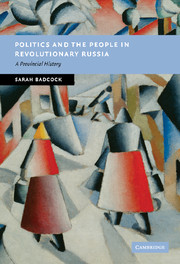Book contents
- Frontmatter
- Contents
- List of figures and table
- Notes on the text
- Acknowledgements
- Maps
- 1 Introduction
- 2 The February revolution: whose story to believe?
- 3 The Socialist Revolutionary Party and the place of party politics
- 4 Choosing local leaders
- 5 Talking to the people and shaping revolution
- 6 Soldiers and their wives
- 7 ‘Water is yours, light is yours, the land is yours, the wood is yours’
- 8 Feeding Russia
- Conclusions
- Bibliography
- Index
- NEW STUDIES IN EUROPEAN HISTORY
8 - Feeding Russia
Published online by Cambridge University Press: 10 August 2009
- Frontmatter
- Contents
- List of figures and table
- Notes on the text
- Acknowledgements
- Maps
- 1 Introduction
- 2 The February revolution: whose story to believe?
- 3 The Socialist Revolutionary Party and the place of party politics
- 4 Choosing local leaders
- 5 Talking to the people and shaping revolution
- 6 Soldiers and their wives
- 7 ‘Water is yours, light is yours, the land is yours, the wood is yours’
- 8 Feeding Russia
- Conclusions
- Bibliography
- Index
- NEW STUDIES IN EUROPEAN HISTORY
Summary
The question of provisions provided a dark heart for the economic and political crises that beset 1917. Russia was not fundamentally short of foodstuffs, but problems of administration and transport conspired to produce food shortages and threats of famine in some areas. Provisions problems steadily worsened through 1917. Russia followed nineteenth-century trends in famines, in that human and institutional factors were more significant than natural scarcity in causing distress and starvation. The government faced concerted resistance from peasant producers in implementing the grain monopoly, and hostility from consumers who were threatened by famine. The split between consumers and producers was between surplus and deficit regions among the peasantry, as well as between town and country. The food crisis also accentuated vertical and horizontal tensions in regional administration and was the issue that provoked most hostility and violence against administrators.
Peter Gatrell's work provides a valuable synthesis of Russia's provisions situation during the First World War, while Lars Lih's study of the provisions crisis during 1917 lucidly explained why and in what form the crisis manifested itself. This chapter explores the mechanics of crisis at grass-roots level, and in doing so exposes some of its peculiarities more clearly. As we have seen in earlier chapters, the panacea to the problems facing Russia in February 1917 was seen to be in enabling Russia's population to rule themselves. It was convenient to blame corrupt and venal tsarist bureaucracy for Russia's woes.
- Type
- Chapter
- Information
- Politics and the People in Revolutionary RussiaA Provincial History, pp. 211 - 237Publisher: Cambridge University PressPrint publication year: 2007

